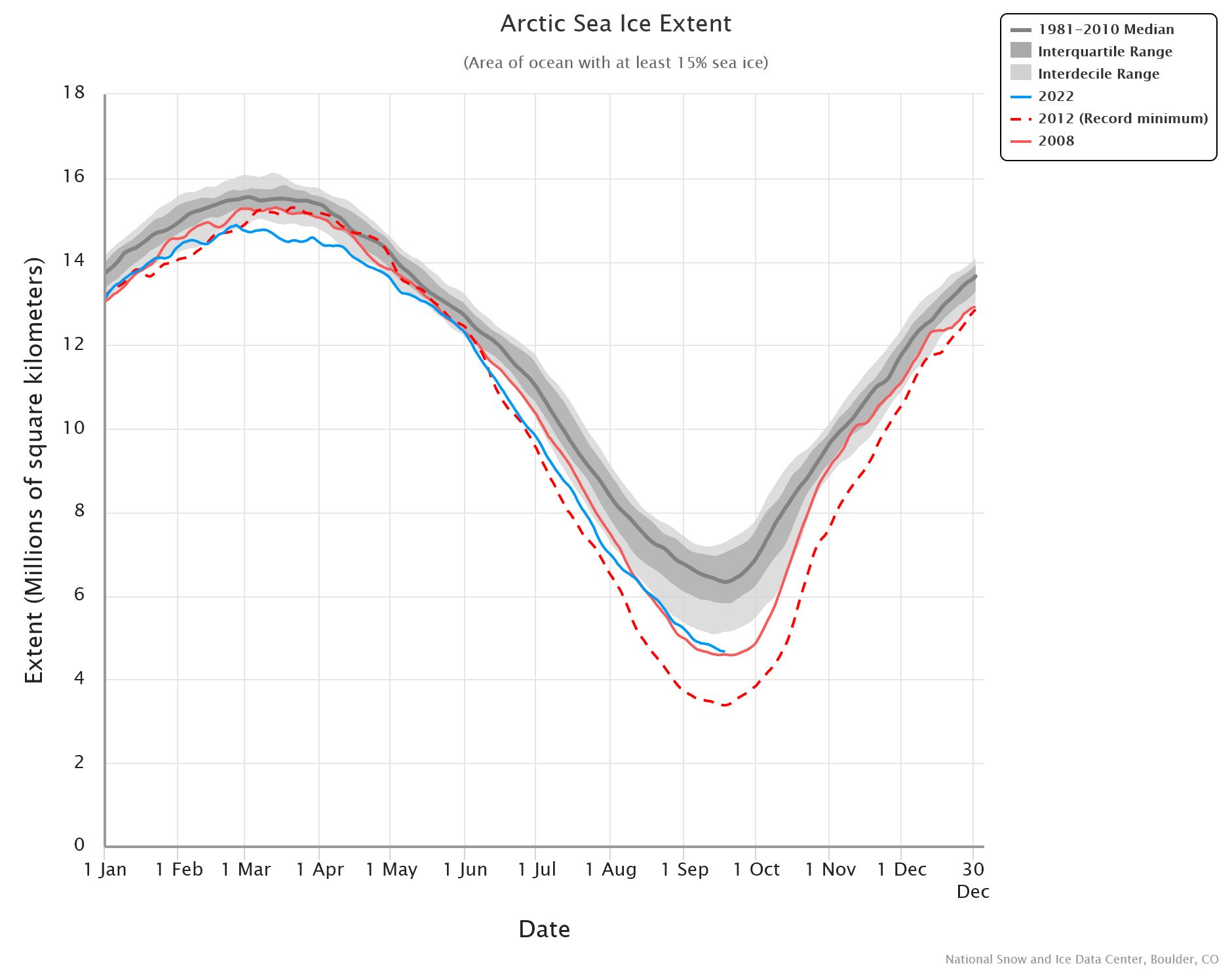Arctic Sea Ice Refuses to Disappear, despite Ever Rising Arctic Temperatures
/The loss of sea ice in the Arctic due to global warming has long been held up by the mainstream media and climate activists as cause for alarm. The ice would be completely gone in summer, they predicted, by 2013, then 2016, then 2030. But the evidence shows that Arctic ice is not cooperating, and in fact its summer extent in 2022 was the same as in 2008. And this stasis has occurred even as Arctic temperatures continue to soar.
The minimum summer Arctic ice extent this month was about 67% of its coverage in 1979, which is when satellite measurements of sea ice in the Arctic and Antarctic began. The figure to the left shows satellite-derived images of Arctic sea ice extent in the summer of 2022 (September 18) and the winter of 2021 (March 7) , which was similar to 2022. Sea ice shrinks during summer months and expands to its maximum extent during the winter.
Over the interval from 1979 to 2022, Arctic summer ice detached from the Russian coast, although it still encases northern Greenland as can be seen. The figure below compares the monthly variation of Arctic ice extent from its March maximum to the September minimum, for the years 2022 (blue curve) and 2008 (red curve). The 2022 summer minimum is seen to be almost identical to that in 2008, as was the 2021 minimum, with the black curve depicting the median extent over the period from 1981 to 2010.
The next figure illustrates the estimated Arctic ice thickness and volume at the 2022 minimum. The volume depends on both ice extent and thickness, which varies with location as well as season. Arctic ice thickness is notoriously difficult to measure, the best data coming from limited submarine observations.
The thickest, and oldest, winter ice currently lies along the northern coasts of the Canadian Arctic Archipelago and Greenland. According to a trio of Danish research institutions, just 20% of the Arctic ice pack today consists of thick ice more than one to two years old, compared to 40% in 1983. Thick, multi-year ice doesn’t melt away in the summer, but much of the ice cover currently formed during winter consists of thin, first-year ice.
What is surprising, however, is that the lack of any further loss in summer ice extent since 2008 has been accompanied by a considerable increase in Arctic temperature. The left panel of the next figure, from a dataset compiled by the European Union’s Copernicus Climate Change Service, shows the mean surface temperature in the Arctic since 1979.
You can see that the Arctic has been warming steadily since at least 1979, when the first satellite measurements were made. As shown in the figure, the mean temperature there shot up by 3 degrees Celsius (5.4 degrees Fahrenheit), compared to global warming over the same interval of only 0.68 degrees Celsius (1.2 degrees Fahrenheit). That’s an Arctic warming rate 4 times faster than the globe as a whole. From 2008 to 2022, during which the summer ice extent remained unchanged on average, the Arctic nevertheless warmed by about 1.3 degrees Celsius (2.3 degrees Fahrenheit).
This phenomenon of excessive warming at the North Pole is known as Arctic amplification, depicted numerically in the right panel of the figure above. The effect shows strong regional variability, with some areas – such as the Taymyr Peninsula region in Siberia and the sea near Novaya Zemlya Island – warming by as much as seven times the global average. The principal reason for the high amplification ratio in these areas is exceptionally low winter ice cover, which is most pronounced in the Barents Sea near Novaya Zemlya.
The amplification is a result of so-called albedo (reflectivity) feedback. Sea ice is covered by a layer of white snow that reflects around 85% of incoming sunlight back out to space. As the highly reflective ice melts from global warming, it exposes more of the darker seawater underneath. The less reflective seawater absorbs more incoming solar radiation than sea ice, pushing the temperature higher. This in turn melts more ice and exposes more seawater, amplifying the warming in a feedback loop.
Interestingly, computer climate models, most of which exaggerate the impact of global warming, underestimate Arctic warming. The models typically estimate an average Arctic amplification ratio of about 2.5, much lower than the average ratio of 4 deduced from actual observations. A recent research study attributes this difference to possible errors in the modeled sensitivity to greenhouse gas forcing, and in the distribution of heating from the forcing between the atmosphere, cryosphere and ocean.
They also suggest that climate models underestimate multi-decadal internal variability, especially of atmospheric circulation in mid-latitudes (30o to 60o from the equator), which influences temperature variability in the Arctic as well.
Next: Climate-Related Disasters Wrongly Linked to Global Warming by Two International Agencies









